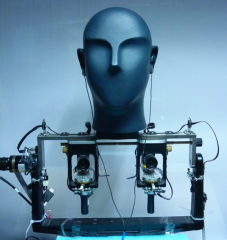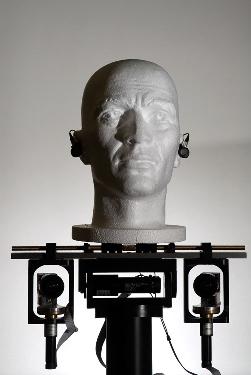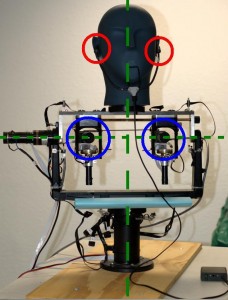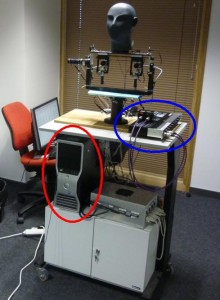The POPEYE robotic head was originally developed by the Robotics group of the University of Coimbra in the framework of the European project POP (Perception on Purpose, FP6-IST-027268, January 2006 – December 2008). Its main components are a four degree of freedom motor system, a stereoscopic camera pair, and an acoustic dummy head with two microphone plugged into its ears. Two of the motors allow pan-tilt motions of the whole device. Two other motors allow independent camera rotations such at to reproduce “eye vergence” in a plane defined by the optical centers and the optical axes of the two cameras.Several prototypes of POPEYE are still in use today (October 2013), one at the University of Coimbra, one at Sheffield University (Speech and Hearing Group) and one at INRIA Grenoble (The PERCEPTION team).
This video shows the pan-and-tilt degrees of freedom of the robot:
An acoustic dummy-head is a device mimicking the shape of a human head, with two microphones in the ear canals. Due to its shape, sounds recorded by the microphones are filtered in a similar way as sounds perceived by humans, i.e., with head related transfer functions (HRTFs). POPEYE-INRIA is equipped with a Sennheiser MKE 2002 dummy head. We advice the reader to listen with earphones to acoustic dummy head recordings. It provides a vivid impression to be immersed into a realistic 3-dimensional auditory scene. Such recordings are called holophonic sounds and can be easily found on Internet. The most famous one is probably the barber shop.
The stereo camera pair mounted on POPEYE allows to achieve vergence movements and stereo reconstruction. The cameras are manufactured by PointGrey; they capture RGB images with up to 1024 x 2048 pixels resolution. The C-mount lenses have a focal length of 8mm, which corresponds to a relatively narrow field of view of approximately 21º x 28º. Controlled camera vergence motions allow to vary the binocular field of view. The cameras deliver synchronized and uncompressed image sequence (up to 30 frames/second) to a PC via a firewire connection.
The setup is deliberately placed in a natural, unconstrained room including furniture and echoic walls, e.g., Figure 3. This allows to carry out experiments in real-world conditions, i.e., with natural reverberations and background noise.






